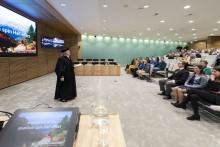For her paper ‘Dramatic voids and where to find them’, Noshahri systematically searched through a decade of articles in Dutch news. ‘The reason I focused on media coverage is because I wanted to show how people’s lives are impacted by sinkholes,’ says the PhD candidate from the Robotics and Mechatronics group at the University of Twente.
‘Sinkholes often happen abruptly and without warning,’ continues Noshahri. ‘They can be small – just big enough for your foot to get trapped in it – or very big, big enough to swallow a car. There have been cases of people who were simply walking or cycling down a street and suddenly were swallowed by the ground. If the sinkhole also damages a water pipe, there is often flooding – which is even more dangerous. You might be cycling and think there is a bit of water, so you just keep going. But you can’t see the sinkhole and fall in, injuring yourself. Sinkholes have caused a lot of disturbance for residents in the Netherlands, and they are also very costly for municipalities.’
Early detection
The doctoral researcher believes there is a strong need to solve this issue, ideally by detecting the voids in time. ‘There are many unanswered questions when it comes to sinkholes. There is no database that accurately records this problem. Even if we know when and where they occurred, we usually don’t know how big the void was before the ground collapsed, if the area had been inspected before and therefore if the forming void was undetected. We need to develop a method that can detect early stages of void formation around sewer pipes. Which is what I’m working towards.’
There is currently no method focused on detection of voids caused by damaged sewer pipes, explains Noshahri. ‘Sewer pipes are commonly inspected by robots equipped with a camera. This gives a lot of useful information on what is happening inside the pipe, but not about its surroundings. If there is a crack in the pipe, you can’t see what type of damage it’s causing outside the pipe. If there is water leaking into the ground, it makes the soil unstable and can lead to void formation – and eventually sinkholes.’
Prototype
That is why the UT scientist works on a robotic platform that uses not only cameras, but also radar and acoustic inspection to find voids outside the sewer pipes. ‘At the UT, we have a prototype of a robot that moves through the pipes and conducts acoustic inspection. This technique is actually quite simple. It’s like tapping on a wall to see if it’s hollow. The robot is equipped with microphones and as it moves around, it taps the pipes’ walls and analyses the sound.’

The prototype functions well in a controlled setting but is yet to be tested in real sewer pipes, explains Noshahri. ‘That is one of the next steps. Right now, I’m very happy that my study on sinkholes has attracted attention, because my goal was to create awareness about this problem and about the research that is still needed in this area.’







